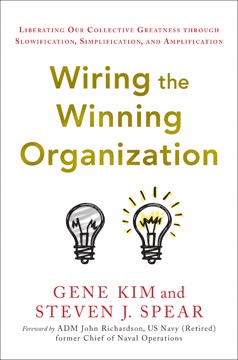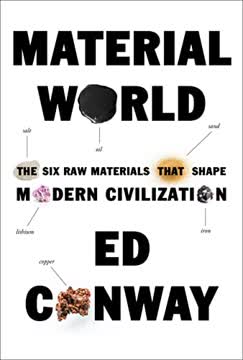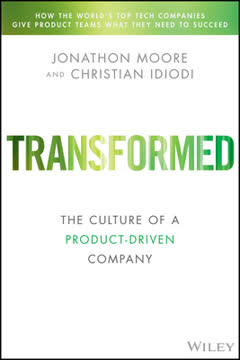Key Takeaways
1. Friction creates gaps between plans, actions, and outcomes
Friction makes doing simple things difficult and difficult things impossible
Knowledge gap: Organizations face uncertainty due to limited information about their environment and future events. This leads to imperfect plans that may not account for all contingencies.
Alignment gap: Even when plans are well-crafted, there's often a disconnect between what leaders intend and what employees actually do. This can be due to miscommunication, misunderstanding, or conflicting priorities.
Effects gap: Actions taken by an organization may not produce the desired outcomes due to unforeseen circumstances, competitors' responses, or complex market dynamics. This unpredictability is inherent in any complex system.
2. Directed opportunism closes the three gaps in strategy execution
Strategy is a system of expedients. It is more than science, it is the application of knowledge to practical life, the evolution of a central idea through continually changing circumstances.
Adaptive approach: Directed opportunism is an approach that combines clear strategic direction with the flexibility to adapt to changing circumstances. It recognizes that perfect plans are impossible and instead focuses on creating a framework for decision-making.
Empowering employees: This approach gives people the autonomy to make decisions within defined boundaries, allowing them to respond quickly to opportunities and challenges as they arise.
Continuous learning: By constantly evaluating outcomes and adjusting actions, organizations can navigate uncertain environments more effectively. This creates a cycle of learning and adaptation that improves strategy execution over time.
3. Strategy is an evolving guiding idea, not a detailed plan
No plan of operations can extend with any degree of certainty beyond the first encounter with the enemy's main body.
Strategic intent: Instead of trying to create detailed long-term plans, focus on defining a clear strategic intent that provides direction without being overly prescriptive.
Flexibility: Recognize that circumstances will change and be prepared to adapt the strategy as new information becomes available. This requires a mindset shift from "plan and implement" to "do and adapt."
Core idea: While tactics and specific actions may change, maintain a consistent core strategic idea that guides decision-making at all levels of the organization. This provides coherence even as individual actions evolve.
4. Effective direction focuses on intent, not micromanagement
Do not command more than is necessary, or plan beyond the circumstances you can foresee
Clear objectives: Communicate the "what" and "why" of objectives clearly, but allow flexibility in the "how." This empowers people to use their judgment and expertise to achieve goals.
Appropriate detail: Provide more specific guidance at lower levels of the organization, but avoid micromanaging. The level of detail should be appropriate to the situation and the capabilities of the team.
Trust: Build a culture of trust where leaders are comfortable delegating authority and employees feel empowered to take initiative within the bounds of the strategic intent.
5. Briefing and backbriefing ensure alignment and understanding
What is said is not yet heard. What is heard is not yet understood. What is understood is not yet believed. What is believed is not yet advocated. What is advocated is not yet acted on. What is acted on is not yet completed.
Clarity of communication: Use a structured briefing process to ensure that strategic intent is clearly communicated at all levels of the organization.
Two-way process: Implement a backbriefing system where subordinates explain their understanding of the objectives and their planned actions. This allows for clarification and adjustment.
Cascading alignment: As the briefing process moves down the organization, each level adds more specificity while maintaining alignment with the overall intent.
6. Organizational structure and culture must support strategy execution
The intelligence of an organization is never equal to the sum of the intelligence of the people within it
Structural alignment: Ensure that the organizational structure facilitates rather than hinders strategy execution. This may require reorganizing to remove barriers to collaboration or decision-making.
Cultural fit: Develop a culture that supports the desired behaviors and mindset needed for effective strategy execution. This includes fostering initiative, learning from mistakes, and adapting to change.
Selection and development: Recruit and develop people who have the skills and mindset to thrive in an environment of directed opportunism. This may require changes to hiring, training, and promotion practices.
7. Metrics should support strategy, not become a fetish
You cannot change leadership style by administrative decree.
Balanced approach: Use metrics to monitor progress and inform decision-making, but avoid letting them become ends in themselves. Remember that not everything that matters can be measured.
Alignment with intent: Ensure that the metrics used are aligned with the strategic intent and encourage the desired behaviors. Be wary of unintended consequences from poorly designed metrics.
Flexibility: Be prepared to adjust metrics as circumstances change or if they prove to be counterproductive. The goal is to support strategy execution, not rigidly adhere to predetermined measures.
8. Leadership requires balancing command, management, and inspiration
The director is detached, calculating, and flexible; the manager is engaged, realistic, and pragmatic; the leader is committed, passionate, and determined
Command: Set clear strategic direction and make key decisions about resource allocation and priorities.
Management: Organize and control resources to effectively implement the strategy. This includes creating systems and processes that support execution.
Leadership: Inspire and motivate people to commit to the strategic intent and give their best efforts. This involves communicating a compelling vision and building a culture of trust and empowerment.
Situational balance: Recognize that different situations may require emphasizing different aspects of this trinity. Effective executives must be able to shift between these roles as needed.
Last updated:
FAQ
What's The Art of Action about?
- Focus on Execution: The Art of Action by Stephen Bungay emphasizes the importance of executing strategy effectively in organizations, exploring the gaps between plans, actions, and results.
- Military Insights: The book draws on military history, particularly the Prussian Army's strategies, to illustrate leadership principles applicable to modern business.
- Directed Opportunism: Bungay introduces "directed opportunism," encouraging leaders to set clear intentions while allowing flexibility in execution to adapt to changing circumstances.
Why should I read The Art of Action?
- Practical Application: The book provides practical techniques for leaders to implement in their organizations, offering a framework for overcoming execution challenges.
- Historical Perspective: By linking military strategy to business practices, Bungay provides a unique perspective that can enhance understanding of leadership and organizational dynamics.
- Improving Performance: Reading this book can help identify and close gaps in strategy execution, leading to improved organizational performance and results.
What are the key takeaways of The Art of Action?
- Three Gaps Identified: Bungay outlines the knowledge gap, alignment gap, and effects gap, which are crucial for effective strategy execution.
- Importance of Intent: Strategy should be framed as an intent rather than a rigid plan, allowing for flexibility and adaptation.
- Empowerment and Trust: Leaders should empower teams to make decisions within a clear framework of intent, fostering trust and independent thinking.
What is "directed opportunism" in The Art of Action?
- Definition: Directed opportunism combines clear intent with flexibility to adapt actions as circumstances change, allowing organizations to seize unforeseen opportunities.
- Balancing Autonomy and Alignment: It emphasizes high levels of autonomy for individuals while maintaining alignment with organizational objectives.
- Practical Implementation: Organizations should create a culture where employees understand the intent behind their actions and feel empowered to make decisions.
How does The Art of Action relate military strategy to business?
- Historical Lessons: Bungay draws parallels between military strategy and modern business practices, arguing that military principles can be applied to organizational leadership.
- Concept of Friction: The book introduces "friction," referring to unpredictable challenges in both warfare and business, helping leaders navigate complexities.
- Leadership Principles: By examining historical military leaders, Bungay identifies key leadership principles that enhance decision-making and execution in business contexts.
What are the three gaps discussed in The Art of Action?
- Knowledge Gap: This gap is the difference between what leaders want to know and what they actually know when making plans, highlighting information limitations.
- Alignment Gap: The disconnect between what leaders want their teams to do and what they actually do, emphasizing the importance of clear communication.
- Effects Gap: The difference between intended effects of actions and actual outcomes, underscoring challenges in predicting action results in complex environments.
How can leaders close the knowledge gap as described in The Art of Action?
- Limit Planning Scope: Focus on planning only what can be realistically anticipated, allowing for flexibility in execution.
- Encourage Judgment: Empower teams to make decisions based on the best available information, fostering a culture of trust.
- Continuous Learning: Adopt a mindset of continuous learning, where teams reflect on outcomes and adapt strategies accordingly.
What techniques can be used to close the alignment gap in The Art of Action?
- Clear Communication of Intent: Articulate a clear intent outlining overall goals and objectives to ensure understanding.
- Backbriefing Process: Implement a backbriefing process for subordinates to confirm their understanding of directives and intentions.
- Empower Decision-Making: Empower teams to make decisions within the framework of the established intent, encouraging ownership and accountability.
How does The Art of Action suggest addressing the effects gap?
- Encourage Adaptability: Foster a culture that encourages individuals to adapt actions based on real-time feedback and changing circumstances.
- Focus on Outcomes: Prioritize outcomes over processes, ensuring teams understand desired results rather than just following prescribed actions.
- Continuous Monitoring: Implement systems for continuous monitoring of actions and effects, enabling timely adjustments to strategies.
What is the significance of "backbriefing" in The Art of Action?
- Ensures Understanding: Backbriefing ensures team members understand their tasks and objectives, allowing for clarification and alignment.
- Promotes Accountability: By confirming understanding, team members take ownership of responsibilities, fostering accountability.
- Facilitates Communication: Enhances communication within teams, reducing misunderstandings and ensuring alignment with expectations.
How does Bungay define the "three levels" of management in The Art of Action?
- Strategy Level: Focuses on long-term goals and overall direction, shaping the future of the organization.
- Operations Level: Translates strategic goals into actionable plans, considering resources and capabilities.
- Tactics Level: Involves execution of specific tasks and processes, supporting operational objectives.
What are the best quotes from The Art of Action and what do they mean?
- “No plan of operations can extend with any degree of certainty beyond the first encounter with the enemy’s main body.”: Emphasizes unpredictability in execution, suggesting adaptability is crucial once action begins.
- “The intelligence of an organization is never equal to the sum of the intelligence of the people within it.”: Highlights the importance of collaboration and communication, suggesting collective intelligence leads to better decision-making.
- “Clarity in intent is crucial for effective execution.”: Underscores the necessity of clear communication of goals and objectives for effective task execution.
Review Summary
The Art of Action receives high praise for its insights on strategy execution, drawing parallels between military history and business management. Readers appreciate Bungay's analysis of knowledge, alignment, and effects gaps, as well as his concept of "directed opportunism." The book is lauded for its practical tools and historical examples, though some find it dense and repetitive. Many consider it a must-read for leaders and managers, offering valuable lessons on empowering teams while maintaining strategic alignment. However, a few reviewers found the military analogies excessive.
Similar Books










Download PDF
Download EPUB
.epub digital book format is ideal for reading ebooks on phones, tablets, and e-readers.




